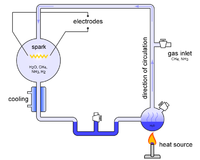
Photo from wikipedia
Abstract Upland soils are thought to be a sink of CH4, the second most important anthropogenic greenhouse gas, owing to oxidation by methanotrophs. To better understand CH4 fluxes in upland… Click to show full abstract
Abstract Upland soils are thought to be a sink of CH4, the second most important anthropogenic greenhouse gas, owing to oxidation by methanotrophs. To better understand CH4 fluxes in upland forests, we quasi-continuously measured CH4 fluxes using an automated closed chamber system over seven years on a larch plantation in a volcanic soil in Japan. We hypothesized that the long-term data sufficiently can calibrate modules for CH4 fluxes, and aimed to predict future pathways of CH4 uptake and their uncertainties in the forest. Based on the observations, a thinning of the overstory only marginally influenced the CH4 fluxes measured by the chambers. Using the data with a Bayesian method, we calibrated four modules for CH4 fluxes in forest soils, which were embedded in the process-based ecosystem model VISIT. The modules well reproduced the observed seasonality, annual budgets, and interannual variability in the CH4 fluxes after calibrating the following parameters: the diffusion coefficient or base CH4 oxidation rate constant and temperature sensitivity. The CH4 fluxes were predicted to increase in the future under the RCP8.5 scenario but to decrease under the RCP 2.6 scenario. The contrasting trajectory was caused by rising and decreasing CH4 concentrations under the RCP 8.5 and 2.6 scenarios, respectively. Furthermore, the magnitudes of the future changes in the fluxes differed in each module because the responses to the changes in the CH4 concentrations were inconsistent among the modules. The observed CH4 fluxes increased with increasing atmospheric CH4 concentration (4.95 mg CH4 m−2 d−1 ppm−1), which was greater in magnitude than those in the modules. Considering the uncertainties in the modules and potential confounding effects in the observations, we conclude that further understanding the responses of CH4 uptake to rising CH4 concentrations is required.
Journal Title: Agricultural and Forest Meteorology
Year Published: 2021
Link to full text (if available)
Share on Social Media: Sign Up to like & get
recommendations!